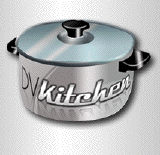Final Cut Pro 7 fortunately now offers many inboard “sharing” features which were very weak or non-existent before. Now FCP7 allows us to export to multiple formats and destinations in a single job (called “Back-End Batch Capability” in my DVKitchen review of March 2009). FCP7 even allows us to export “in the background”, so we can keep on editing if we’d like. Thanks to FCP7’s improved integration with Apple’s Compressor, some of the encoded formats can be published directly to web destinations, whether they be MobileMe, YouTube, or even your own FTP server (after you’ve previously made a preset destination for it in Compressor). These are all welcome improvements, which are directly accessible from FCP7. However, DVKitchen is still a vital tool (especially if you’re encoding for MobileMe, your own web server… or your client’s web server), because it includes the following unique and must-have features not included in FCP7/FCS3.
Unique features in DVKitchen, not found in FCP7/FCS3:
- Bit Rate Calculator
- SampleLab
- Media Publishing Room
I covered these features in detail back in the March 2009 DVKitchen review, but here’s an executive summary:
DVKitchen’s Bit Rate Calculator helps you quickly and easily determine your bit budget depending upon several factors, including the average length of your web videos, your server’s bandwidth , and how many seconds you think is reasonable for internauts to wait before seeing the video start playing.
DVKitchen’s SampleLab helps you find the TOQ (Threshold of Quality) of your encoded video, which is extremely useful when encoding video for the web. If your video is too compressed, you will see undesired artifacts in your video. If your video is not compressed enough, it will take more space on your server and take longer for internauts to begin seeing your video. Just like Goldilocks in The Story of the Three Bears, who didn’t want her porridge “too hot”, or “too cold”. She wanted it “just right”. Well that’s a way of understanding your video’s TOQ. You can use DVKitchen’s SampleLab to determine your video’s TOQ, even if you are going to do the actual full encoding with any other tool, including doing it directly from FCP7!
DVKitchen’s Media Publishing Room is another unique DVKitchen function where you pick videos (which may already be on your server, and may have been encoded using any other tool, now even possibly FCP7), choose several technical and esthetic options about how to present them on the web, and then have the Media Publishing Room generate the HTML code for you, either for a full web page, or for an HTML snippet for you to paste on your page, blog, or in a forum. In my experience, the HTML code provided by DVKitchen’s Media Publishing Room is even compatible with iWeb ’09! Among the publishing options are: raw H.264, embedding H.264 into a Flash player on the website without any re-encoding, and ShadowBox.
As you read here, this US$79 program is still a vital tool to calculate the ideal bit rate for your web video, and to embed your H.264 video in a Flash player, which makes it playable in all Mac and Windows computers, even those Windows computers which don’t have QuickTime installed. And as long as you design your website accordingly, iPhones and other mobile devices can access the same H.264 file directly (without the Flash player), so you can have your cake and eat it too! These features are extremely valuable, even if you choose to do the actual encoding with FCP7 (using Compressor’s engine in the background). For full details, please read (or re-read) the full DVKitchen review here. If you decide to purchase DVKitchen, take advantage of the special 5% discount we have negotiated for our readers, podcast listeners, and seminar atendees, by entering the code TecnoTur on the DVCreators’s DVKitchen website.
SFTP means Secure FTP
As many of our readers and seminar attendees know, I have long been an advocate of SFTP over regular FTP. With regular FTP, your password unfortunately travels through the Internet without any encryption at all, meaning that any hacker could easily “sniff” it, and take down your site. On the other hand, SFTP encrypts the password before transmission. Fortunately, several tools include SFTP, including Fetch, iWeb ’09, and Übercaster. Ironically, as of the date I am publishing this article, neither Apple’s Compressor nor DVKitchen supports SFTP. I hope that both will add it soon. In the meantime, I don’t expect you to publish to a local folder and then use Fetch to SFTP (too many steps and too much time), but I do recommend creating a separate unprotected FTP for the media you upload using unencrypted FTP tools like Compressor and DVKitchen. That way, if a hacker does sniff your password, s/he won’t be able to take down your entire website, but just the media. And Apple and DVCreators: Please add SFTP to your programs ASAP!
Allan T©pper’s seminars are listed at AllanT©pper.com, and his TecnoTur podcast is available free in iTunes or at TecnoTur.us.

